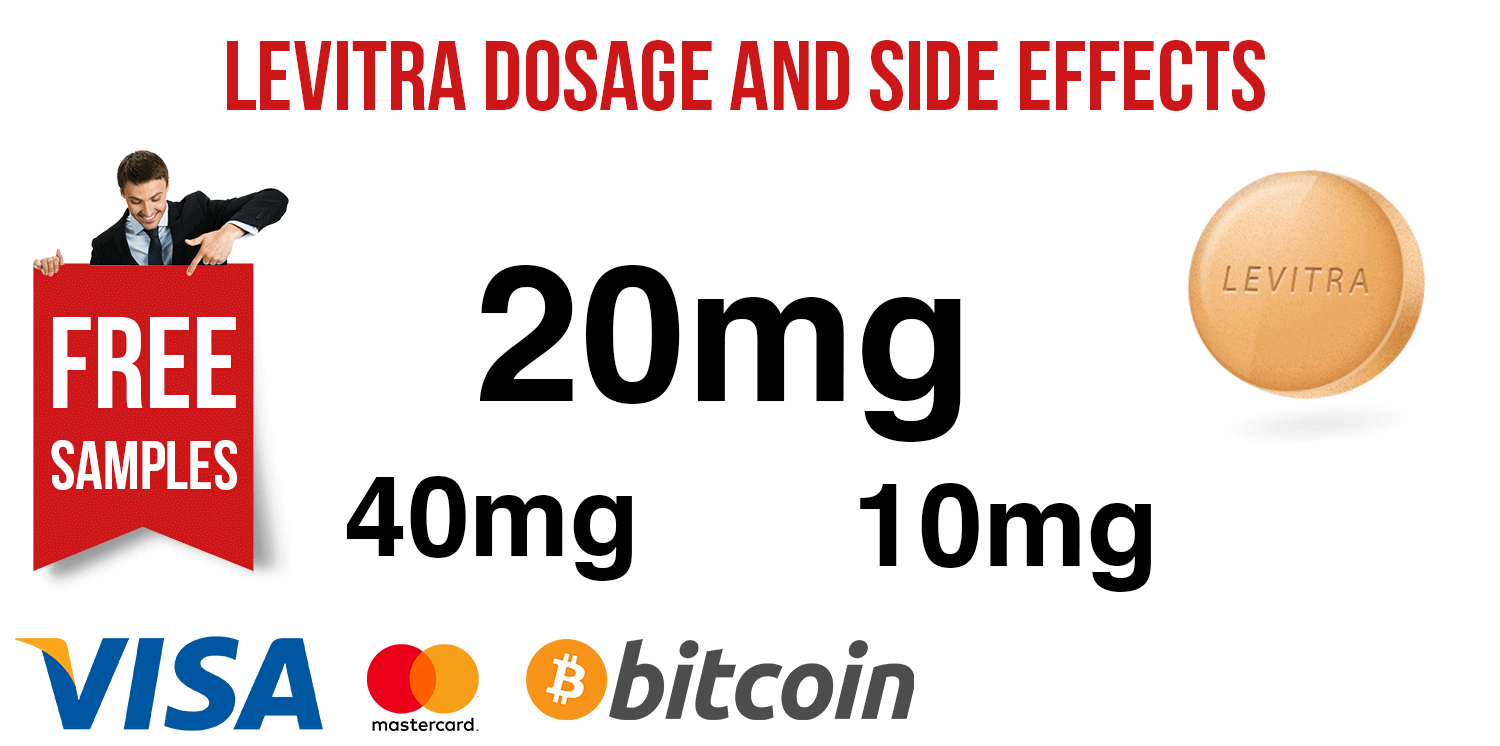Levitra Dosage and Side Effects
Increasing Levitra dosage should be done in response to doctor recommendation depending on reported results and side effects.
Depending on a patient’s physical condition, prescription of Levitra may vary. Consult with a doctor to find out if you are a potential patient for taking Levitra. Your physician will be able to provide information and prescription of the proper Levitra dose.
Patients taking the drug Levitra should be aware that allergic reactions such as difficulty breathing, hives, and swelling of the face, lips, throat and tongue is common and should be avoided. Serious symptoms associated with the drug Levitra such as overdose, or loss of vision, hearing, or pulse signal that a patient should stop using Levitra and seek emergency medical treatment.
Other side effects of vardenafil medication, such as erections exceeding 4 hours, seizures, convulsions, dizziness, migraine headaches and vomiting are a sign that a patient is having a negative reaction. For advice about choosing the correct dose of vardenafil, and side effects related to Levitra treatment, read below.
Levitra Dosing
Levitra (vardenafil) dosage is often a progressive decision based on a doctor’s recommendation. The standard prescribed dose is once a day. Some doctors may prescribe alternate treatment. The initial adult dosage recommended for Levitra treatment of erectile dysfunction is a 10 mg tablet, taken orally, once a day.
Some doctors prescribe Levitra as needed. “As needed” dose of the drug can be taken 1 hour prior to sex. For patients 65 years or older, the initial dose of Levitra is generally a 10 mg tablet orally, once a day as needed, approximately 60 minutes prior to sexual activity.
The prescribed dosage of vardenafil may increase to 40 mg tablet, or decrease to 10 mg, based on a patient’s reaction to the drug. Maximum dosage for Levitra is a 20 mg tablet once a day. In cases where a patient is already undergoing stable alpha-blocker therapy, the initial dose of Levitra should be 10 mg orally once a day. A time interval between the dosages is recommended for the most effective results to treatment.
How to Choose the Right Dosage?
Patients electing to be treated by Levitra (vardenafil) are typically prescribed a 10 mg dose initially. Levitra is taken orally as needed and should be ingested one hour just before sexual stimulation. Work with your physician to choose the right dosage and sizes of vardenafil tablets to meet your treatment needs.
Increasing Levitra dosage should be done in response to doctor recommendation depending on reported results and side effects. Doses of Levitra should be taken no more than once a day. The maximum recommended dosing frequency of vardenafil tablets is once per day with or without food intake.
Overdose
Serious side effects to the drug Levitra (vardenafil) may be an indicator that someone has taken more than a single daily dose. If a patient is exhibiting signs of an overdose, contact emergency at 911. Patients sustaining side effects such as blurred vision or erratic breathing should call the U.S. national poison control hotline at 1-800-222-1222. Residents of Canada should contact their nearby provincial poison control center.
Why Are the Dosages of Levitra and Viagra Different?
With a reputation as the best impotence medication available by prescription, Levitra comes in 20 mg, 40 mg, 60 mg, and 10 mg strengths. No 80 mg Levitra pill is currently on the market.
Max daily intake of Levitra prescription or similar versions of the drug in its generic (vardenafil) forms should not exceed recommended directions for use. Patients with normal health status generally start at a single 10 mg tablet dosage per day. Recommended dosages of the drug Levitra (vardenafil) for specific patient populations are as follows:
- Geriatrics – initial dose of 10 mg Levitra for patients over the age of 65 years.
- Hepatic Impairment – patients diagnosed with hepatic impairment (Child-Pugh B) should initiate taking Levitra at a dosage of 10 mg, and not exceeding a maximum dosage of 20 mg daily, at any time. If a patient has been diagnosed with severe hepatic impairment (Child-Pugh C), Levitra and other vardenafil medications should not be prescribed.
Levitra Side Effects
Patients taking the Levitra (vardenafil) concomitantly with other prescription drugs, alcohol, narcotics, or grapefruit juice, may experience side effects caused by an adverse reaction to the medication.
The correlation between Levitra dosage and side effects may be associated with the starting of the erectile dysfunction treatment during an ongoing medical intervention or drug therapy. It is important to know the nature of the current therapy and the intended concomitant use with Levitra.
Common and rare side effects to Levitra such as back pain, flushing, blocked breathing of the nose, chest pain, dizziness, fainting, irregular heartbeat, ringing of the ears, seizure, sudden vision loss, swelling of limbs, upset stomach, or erections lasting more than 4 hours are a sign that Levitra is causing an adverse reaction in a patient.
Drug interactions may alter how another medication works and can increase the risk for serious side effects. This includes the use of Levitra with other impotence medication, unless a physician has prescribed concomitant treatment. Unless a patient is experiencing side effects, they should not stop or change the prescribed dosage of vardenafil drugs, unless instructed to do so by a doctor.
Nitrates, Guanylate Cyclase (GC) Stimulators, and CYP3A4 Inhibitors prescribed concomitantly with Levitra are known to cause side effects when not taken in intervals. CYP3A4 Inhibitors may interfere with Levitra depending on dose size, where not taken at an interval rate of 24 to 72 hours. For example, no more than a single dose of 2.5 mg Levitra should be taken during a 72-hour period, if a patient is undergoing CYP3A4 Inhibitor treatment.
When commencing Levitra treatment, ask a doctor: how long does it last? By taking Levitra (vardenafil) medication at intervals with another drug during concomitant therapy, you can avoid side effects that may occur in response to the treatment.
The following is a list of common and rare side effects to taking Levitra (vardenafil).
Common:
- back pain;
- flushing of the face, neck, or chest;
- difficulty breathing through the nose;
- dizziness;
- headache; or
- stomach upset.
Rare:
- chest pain;
- convulsions;
- fainting;
- irregular heartbeat;
- ringing of the ears;
- shortness or loss of breath;
- sudden loss of hearing;
- sudden loss of vision;
- swelling of the limbs;
- penis erection lasting more than 4 hours; or
- seizure.
Other Warnings
Some medications may be dangerous when taken with the drug Levitra (vardenafil). It is not recommended taking Levitra with similar impotence medicines like tadalafil (Cialis), avanafil (Stendra), and sildenafil (Viagra). Mixing medications for ED can lead to morbidity or even mortality when done without the approval of a physician.
Other pharmaceutical medications prescribed for the treatment of pulmonary arterial hypertension such as Adcirca and Revatio types of products, should not be taken with Levitra. Antibiotic, antifungal, high blood pressure, prostate, heart rhythm and HIV/AIDs therapy medications taken concomitantly with Levitra may cause unwanted side effects leading to short-term and long-term secondary health conditions. If you experience adverse side effects associated with Levitra (vardenafil) or its generic forms, contact a doctor or pharmacist to find out if you are allergic to the drug and its use. Get our free Levitra samples delivered by mail.

 Real 10 Free Samples of Viagra 100mg for Men
Real 10 Free Samples of Viagra 100mg for Men Pack of Cialis 20mg 10 Free Samples
Pack of Cialis 20mg 10 Free Samples Free Levitra Samples 10 x 20 mg
Free Levitra Samples 10 x 20 mg

